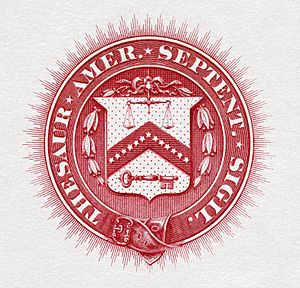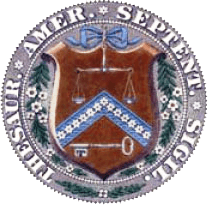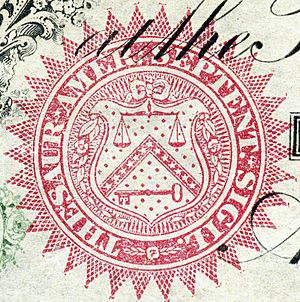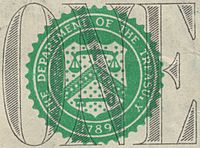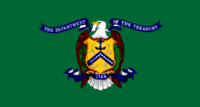Symbols of the United States Department of the Treasury facts for kids
The United States Department of the Treasury has special symbols that represent it. These are the Flag of the Treasury Department and the U.S. Treasury Seal. The seal is actually older than the department itself! It was first used by the Board of Treasury before the United States became a country. Today, you can see the seal on all U.S. paper money. It also appears on official documents from the Treasury Department.
The seal has a design called a chevron. This shape looks like an upside-down "V". Inside the chevron are thirteen stars. These stars stand for the original thirteen states of the U.S. Above the chevron, there is a balance. This balance represents fairness and justice. Below the chevron, you will see a key. The key is a symbol of power and trust.
Around the edge of the seal, it says "THE DEPARTMENT OF THE TREASURY". At the very bottom, it shows the year "1789". This is the year the department was created.
Contents
The U.S. Treasury Seal: What It Means
Quick facts for kids Seal of the Department of the Treasury |
|
|---|---|
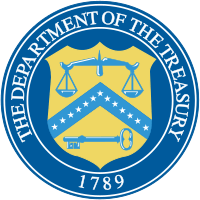 |
|
| Armiger | U.S. Department of the Treasury |
| Adopted | January 29, 1968 |
| Torse | THE DEPARTMENT OF THE TREASURY - 1789 |
| Blazon | Chevron with thirteen stars, a balance, and a key. |
| Earlier version(s) |  |
| Use | To represent the organization and to authenticate currency and certain documents. |
How the Treasury Seal Was Created
In 1778, a group of important people, including John Witherspoon and Gouverneur Morris, were asked to design seals. They needed seals for the Treasury and the Navy. While they designed a Navy seal, there is no clear record of them designing a Treasury seal.
The person who actually created the U.S. Treasury seal was Francis Hopkinson. He was one of the people who signed the Declaration of Independence. He also helped design the Great Seal of the United States. Hopkinson later asked Congress for payment for his designs. These designs included flags, money, and several seals. One of these was for the Board of Treasury.
The Treasury seal was first used in 1782. When the U.S. government started in 1789, the new Department of the Treasury kept using this same seal.
Changes to the Treasury Seal Over Time
The first seal had more decorations. It also had a Latin phrase around the edge. This phrase was "THESAUR. AMER. SEPTENT. SIGIL." This means "The Seal of the Treasury of North America." No one knows for sure why it said "North America." However, the first national bank, started in 1781, was called the Bank of North America.
After almost 200 years, the Treasury Secretary, Henry H. Fowler, approved a new seal. This happened on January 29, 1968. The new seal was simpler. The Latin words were replaced with "THE DEPARTMENT OF THE TREASURY" in English. The year "1789" was also added at the bottom.
The Treasury Seal on U.S. Money
The Treasury seal has been printed on almost all U.S. paper money. This started with the Legal Tender Notes in 1862 and continues today. Only a few early types of money, like the Demand Notes of 1861, did not have the seal. This was because the laws for those notes did not require it.
At first, the U.S. government could not print money by itself. Private companies printed the first paper bills. Then, they sent them to the Treasury Department for the final steps. This included adding the seal to the notes. Even now, the serial number and seal are printed on the money after the main design is finished. This process was the beginning of what is now the Bureau of Engraving and Printing. In July 1869, the Bureau started printing all the money itself.
For many years, the color and style of the seal on money changed a lot. The basic seal was the same. But the edges were decorated with different patterns. The seal was printed in colors like red, blue, and brown.
The way the seal was used became standard starting with the smaller-sized money from 1928. The seal was printed with a toothed outer edge. Its color showed what type of money it was. For example, Federal Reserve Notes had a green seal. Silver certificates had a blue seal. United States Notes had a red seal.
During World War II, special money was printed for use only in Hawaii. These bills had the word "HAWAII" on both ends. They were used between 1942 and 1944. The seal and serial numbers were brown. This was done so that if Hawaii was captured by enemies, these special notes could be made worthless.
Similar special money was made for U.S. troops in North Africa in 1942. These notes had a bright yellow Treasury seal. Again, this was so they could be made worthless if they fell into enemy hands.
In 1950, the design of Federal Reserve Notes changed slightly. A smaller seal was used. The 1968 version of the Treasury Seal was first used on a $100 United States Note in 1966. It was then put on all Federal Reserve Notes starting in 1969.
The "Watchdog" Seal
There is also an old "watchdog" seal from around 1800. We don't know much about where it came from or how much it was used. It is no longer on Treasury documents. However, the original printing plate for this seal is kept safe.
This seal shows a strongbox, which is like a safe. On top of the strongbox are the Scales of Justice. Next to the strongbox is a strong-looking watchdog. The dog is holding a large key with its paw. The seal says "U.S. Treasury" and has a wreath around it. The scales and the key are also on the official Treasury seal used today.
The United States Mint actually had a real watchdog named Nero. Nero was bought in 1793 for $3. He would go with the night watchman on his rounds. Treasury records show money was spent on Nero and other watchdogs for 25 years. Today, there is a watchdog named Sherman. Some people believe Nero is the dog shown on the seal. He might even be the reason we use the phrase "Watchdog of the Treasury."
The Treasury Department Flag
The Flag of the Treasury Department was approved on January 11, 1963. It was first shown on July 1, 1963. The flag has a light green background. On it, there is a shield resting on an eagle. The eagle holds a scroll in its beak that says "The Department of the Treasury." This scroll is blue with white letters.
In its claws, the eagle holds another scroll. This scroll has the year "1789" in white. The shield on the flag is yellow with brown outlines. It has an oak branch on the right and an olive branch on the left. There is also a blue chevron with 13 white stars. Below the chevron is the traditional Treasury key in white. Above the chevron are the balancing scales in white, which represent justice.
Flags for Treasury Officials
Besides the main department flag, there are also special flags for different U.S. Treasury officials. For example, the U.S. Secretary of the Treasury has their own flag.
-
The current flag for the U.S. Secretary of the Treasury.


